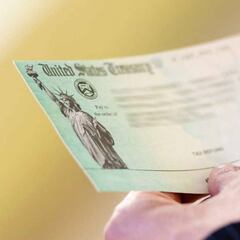How has US economy changed since the first, second and third stimulus check were approved?
The US economy has still not fully recovered from the pandemic in February 2020, but the stimulus checks have gone a long way to helping people.


The covid-19 pandemic has been characterized by extreme suffering and illness, but will also be remembered for a social welfare system never before seen in the US. Residents were bombarded with checks from the government to keep them afloat as the economy entered free-fall, receiving thousands of dollars in support.
Inevitably, this has led to deep changes in the American economy. Some of the standout features are a decrease in unemployment, a staving off of food insecurity for many, but high levels of inflation.
Related news:
- Will Social Security beneficiaries get a fourth stimulus check?
- How much money has been paid in Golden State stimulus in California?
- Fourth Stimulus Check Update: what's the situation in every state?
- Will a new stimulus check happen in November 2021?
First stimulus
The CAREs Act was signed into law by President Trump on 27 March 2020.
Shortly after, the IRS quickly began distributing $1,200 stimulus checks. When the checks were sent, the unemployment rate in the United States stood at 14.8 percent. Additionally, in late April, 38 percent of respondents to the Household Pulse Survey (HPS) had reported that they believed they or someone in their household would lose income in the next four weeks.
By early May, many households had received their stimulus check. However, rates of food insecurity did not drop quickly as a result. The HPS asks respondents if within the last seven days there was “either sometimes or often not enough to eat.” In the six weeks following the sending of the first check, around one in ten households reported that they were experiencing food insecurity.
Families that experienced food insecurity in 2020
| Date | Amount of families (in percent) |
| April 23- May 5 | 9.8 |
| May 7-12 | 10.6 |
| May 14-19 | 10.8 |
| May 21-26 | 9.9 |
| May 28 - June 2 | 10.7 |
| June 4-9 | 10.3 |
At the start of the pandemic, inflation fell to near zero, but steadily rose soon after. By the time of the second check, inflation was at 1.2 percent, much lower than the Federal Reserve aim of 2 percent.
Unemployment began to come down too. After rocketing up to more than 15 percent, the first stimulus check helped bring it down to 6.7 percent. This till represented a huge increase on the less than 4 percent pre-pandemic level.
Second Stimulus
In December 2020, Congress passed the Coronavirus Response and Relief Supplemental Appropriations (CRRSA) Act of 2021, which included funding to send a $600 stimulus check.
By the time the second payment was made, households were struggling.
In early December 2020, food insecurity hit an all-time high. Almost 20 percent of adults with children reported that they “sometimes or often” did not have access to enough food.
Even without unemployment and other stimulus (government transfers), U.S. incomes are going up.
— Tracy Alloway (@tracyalloway) November 1, 2021
Chart via Barclays: pic.twitter.com/SaV93J2LCz
Additionally, 35 percent reported having trouble covering basic expenses. With the size of the check being so much smaller than the first, it did not have the same impact on people’s spending habits. By the end of January, the 35 percent figure remained unchanged.
Unemployment continued to decrease, though much slower, falling from 6.7 percent to 6 percent. Inflation finally crossed the 2 percent threshold, jumping to 2.6 percent by the time of the third stimulus.
Third Stimulus
Much larger than the second, the third stimulus check was President Biden's first, totaling $1,400. This was despite promising $2,000 checks in his election run.
Related stories

Fourth Stimulus Check Update: what's the situation in every state?
Researchers at the University of Michigan found that through the passage of the CRRSA and the ARP, hardship, as reported by respondents, dropped sharply, particularly among “adults with children, and adults living in households with annual incomes less than $25,000.” The downward trend was seen by those with higher incomes as well.
Get details on people’s income and spending in September; read our latest blog, https://t.co/MujTUREGB0 pic.twitter.com/b8oONL91a1
— BEA News (@BEA_News) October 29, 2021
The third stimulus saw the highest inflation, rising to 5.4 percent as of publication, the highest for decades. This is now putting the squeeze on Americans' bank accounts as their saved money quickly becomes less and less worth. A positive has been the unemployment rate, which is just under 5 percent, nearly at pre-pandemic levels.
